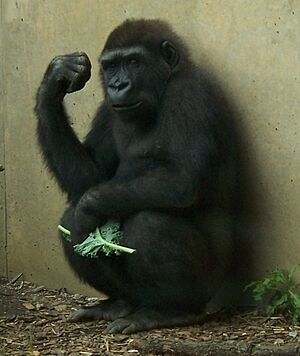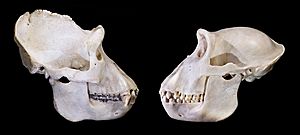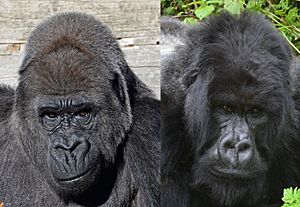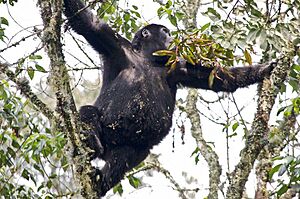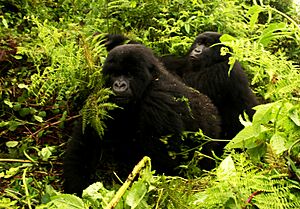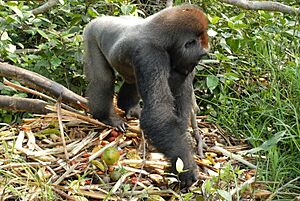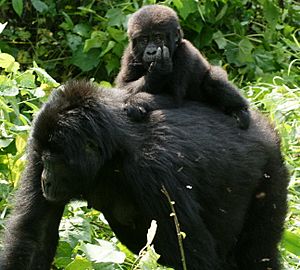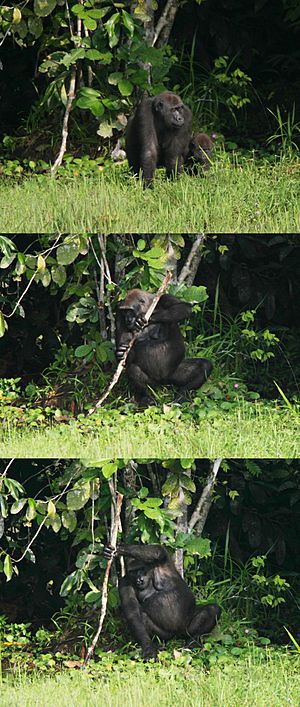Gorilla facts for kids
Quick facts for kids Gorilla |
|
|---|---|
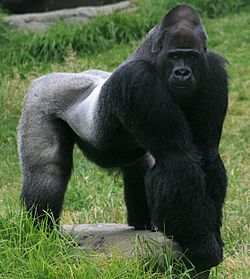 |
|
| Silverback male Gorilla gorilla | |
| Scientific classification | |
| Kingdom: | |
| Class: | |
| Order: | |
| Family: | |
| Subfamily: | |
| Genus: |
Gorilla
|
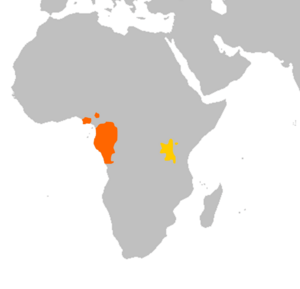 |
|
| Distribution of gorillas | |
Gorillas are large, powerful apes that live on the ground. They mostly eat plants and can be found in the forests of central Sub-Saharan Africa. There are two main types, or species, of gorilla: the eastern gorilla and the western gorilla. Both are in danger of disappearing forever, meaning they are critically endangered. Gorillas are the biggest living primates on Earth.
Gorillas are very closely related to humans. Their DNA is about 95–99% the same as ours! They are our closest living relatives after chimpanzees and bonobos. Gorillas live in tropical or subtropical forests across Africa. They can be found at many different heights, from sea level to high up in mountains. For example, mountain gorillas live in cloud forests in the Virunga Mountains, very high up. Lowland gorillas live in dense forests and swamps closer to sea level.
Contents
What Does the Name "Gorilla" Mean?
The name "gorilla" comes from an old story. Around 500 BC, a Carthaginian explorer named Hanno the Navigator went on a trip along the west African coast. His group met "savage people" who were very hairy, mostly women. Their interpreters called them "Gorillae." Later, this word was used for the ape species. We don't know for sure if these "Gorillae" were actually gorillas, other apes, or even humans.
In 1847, two American naturalists, Thomas Staughton Savage and Jeffries Wyman, officially described the western gorilla. They used the name Troglodytes gorilla, taking the word from Hanno's story.
Gorilla Family Tree: Evolution and Types
Gorillas are part of a family that also includes chimpanzees and humans. All of us came from a common ancestor about 7 million years ago. Scientists used to think there was only one species of gorilla with three types. But now, most agree there are two species, each with two or three types, called subspecies.
These different gorilla types developed during the Ice Age. Their forest homes became smaller and separated, causing the gorillas to evolve differently. Scientists are still learning about all the connections between gorilla groups. For example, some think the Bwindi gorillas might be a third type of mountain gorilla.
Gorilla types can look different in many ways. This includes how thick their hair is, their size, hair color, and even their faces.
Physical Characteristics of Gorillas
Gorillas usually walk on all fours, using their knuckles. This is called knuckle-walking. But they can also walk on two legs for short times, especially when carrying food or if they feel threatened.
Wild male gorillas are much larger than females. Males can weigh between 135 to 195 kg (298 to 430 lb). Females are about half that size, weighing 70 to 115 kg (154 to 254 lb). Adult males are also taller, standing 1.5 to 1.8 m (5 to 6 ft) tall, with very long arms that can stretch 2.3 to 2.6 m (7.5 to 8.5 ft). Females are shorter with smaller arm spans.
Older male gorillas are called silverbacks. This is because they grow a patch of silver hair on their backs as they get older. The biggest gorilla ever recorded was 1.95 m (6 ft 5 in) tall and weighed 219 kg (483 lb).
Gorillas have dark brown eyes with a black ring around the colored part. Like humans, each gorilla has unique fingerprints.
Where Gorillas Live
Gorillas live in different parts of Africa, but their homes are spread out. The large Congo River separates the homes of the two main gorilla species. Western gorillas live in west-central Africa, while eastern gorillas live in east-central Africa.
Gorillas live in many kinds of places, from high mountains to swamps. Mountain gorillas live in forests high up, sometimes over 4,000 meters (13,000 ft) above sea level. Eastern lowland gorillas live in forests that are lower down. Western gorillas can live in both lowland swamp forests and mountain forests.
Gorilla Nests
Gorillas build nests to rest in during the day and to sleep in at night. These nests are simple, made from branches and leaves. They are usually about 2 to 5 feet wide. Unlike chimpanzees or orangutans, gorillas often build their nests on the ground. Young gorillas sleep with their mothers. But once they are about three years old, they start building their own nests, usually close to their mother's. Building nests is a smart skill for gorillas, showing how they use tools from nature.
What Gorillas Eat
A gorilla's day is split between resting and looking for food. What they eat depends on where they live. Mountain gorillas mostly eat leaves, stems, and shoots. Fruit is not a big part of their diet. Their food is easy to find, so they don't have to compete much or travel far. They usually move less than 500 meters (0.3 miles) each day.
Eastern lowland gorillas eat a wider variety of foods. They eat leaves and stems, but fruit can make up a quarter of their diet. Since fruit is harder to find, they travel farther each day. They also enjoy eating insects, especially ants.
Western lowland gorillas rely even more on fruit. They travel the farthest each day to find food. They also eat termites and ants. Gorillas rarely need to drink water because the plants they eat contain a lot of water, and they also get water from morning dew.
Gorilla Behavior
Social Life: Living in Groups
Gorillas live in family groups called troops. A typical troop has one adult male, called a silverback, several adult females, and their young. Sometimes, there can be more than one male in a troop. A silverback is usually over 12 years old and gets his name from the silver hair on his back. He also has large canine teeth.
Both male and female gorillas often leave their birth groups when they grow up. Males usually leave to start their own troops by attracting females. However, some male mountain gorillas stay with their birth troop and become helpers to the silverback. If the silverback dies, these males might take over the group.
The silverback is the leader of the troop. He makes all the decisions, settles fights, decides where the group goes to find food, and keeps everyone safe. Younger males, called blackbacks, are 8 to 12 years old and don't have silver hair yet. They help the silverback protect the group.
The bond between a silverback and his females is very important. They groom each other and stay close. Females form strong relationships with males for protection and to have babies. While fights can happen between males and females, they rarely cause serious harm. Females in a troop who are related tend to be friendly. Otherwise, females might not interact much and can sometimes be aggressive toward each other.
Males in all-male groups tend to be friendly. They play, groom each other, and stay together. Serious fights are rare in stable groups. But if two mountain gorilla groups meet, the silverbacks might fight, sometimes to the death.
Who Are Gorilla Predators?
One possible predator of gorillas is the leopard. Sometimes, gorilla remains are found in leopard droppings, but this could be from leopards eating gorillas that were already dead. If a group is attacked by humans, leopards, or other gorillas, the silverback will bravely protect his troop, even if it means risking his own life. There have been stories of a silverback gorilla and a leopard being found dead after fighting each other.
Reproduction and Parenting
Female gorillas can have babies when they are about 10–12 years old. Males can father babies when they are 11–13 years old. A gorilla pregnancy lasts about 8.5 months. Female mountain gorillas usually have their first baby at 10 years old and then have a baby every four years. Gorillas can mate all year round.
Baby gorillas are very helpless and need their mothers a lot. Mothers are the main caregivers and are vital for their babies' survival. Male gorillas don't actively care for the young, but they help them learn how to interact with other young gorillas. The silverback protects the infants in his troop from any aggression.
For the first five months, babies stay very close to their mothers. They also sleep with their mothers in the same nest. After five months, babies start to move away from their mothers for short times. By 12 months old, they might move up to 5 meters (16 ft) away. When they are about 18–21 months old, they spend more time away from their mothers.
At three years old, gorillas become juveniles. This lasts until they are six. At this age, they stop drinking their mother's milk and sleep in their own nests. After a mother's baby is weaned, she can become pregnant again. Having other gorillas, like the silverback, to play with helps make weaning easier for the mother and baby.
How Gorillas Communicate
Gorillas use about 25 different sounds to communicate, especially in thick forests. Grunts and barks are common when they are traveling. These sounds tell other group members where everyone is. They can also be used to keep order in the group. Screams and roars mean there is danger or a warning, and silverbacks often make these sounds. Deep, rumbling burps mean they are happy and are heard when they are eating or resting. This is the most common way they talk within their group.
Gorillas often try to solve problems without fighting. They use displays and threatening behaviors to scare others away. The "charge display" is special to gorillas. It has nine steps:
- 1. Hooting faster and faster.
- 2. Pretending to eat.
- 3. Standing up on two legs.
- 4. Throwing plants.
- 5. Beating their chest with cupped hands.
- 6. Kicking with one leg.
- 7. Running sideways, sometimes on two legs, sometimes on four.
- 8. Slapping and tearing plants.
- 9. Thumping the ground with their hands to end the display.
Lifespan of Gorillas
Gorillas usually live for 35 to 40 years in the wild. But gorillas in zoos can live much longer, sometimes over 50 years. The oldest known gorilla was a female named Colo, who lived at the Columbus Zoo and Aquarium. She was 60 years old when she passed away in 2017.
Gorilla Intelligence
Gorillas are very smart animals. Some gorillas in captivity, like Koko, have even learned to use sign language. Like other great apes, gorillas can laugh and feel sadness. They have rich emotional lives and form strong family bonds. They can also make and use tools, and they can think about the past and the future. Some researchers even believe gorillas might have spiritual feelings. They have different "cultures" in different areas, such as how they prepare food. They also show individual preferences for colors.
Gorillas Using Tools
Scientists have seen gorillas using tools in the wild! In 2005, a female gorilla in the Nouabalé-Ndoki National Park in the Republic of the Congo used a stick to check how deep the water was while crossing a swamp. Another female used a tree stump as a bridge and as a support while looking for food in the swamp. This means that all great apes are now known to use tools.
Also in 2005, a young gorilla in the Republic of the Congo was seen using rocks to crack open palm nuts. While this was the first time a gorilla was seen doing this, chimpanzees have been using tools to "fish" for termites for over 40 years. Great apes have good hand control and can use simple tools, and even make weapons like a club from a fallen branch.
Related pages
Images for kids
-
Drawing of French explorer Paul Du Chaillu at close quarters with a gorilla
-
Eastern lowland gorilla in the Kahuzi-Biega National Park, Democratic Republic of the Congo
See also
 In Spanish: Gorilas para niños
In Spanish: Gorilas para niños


